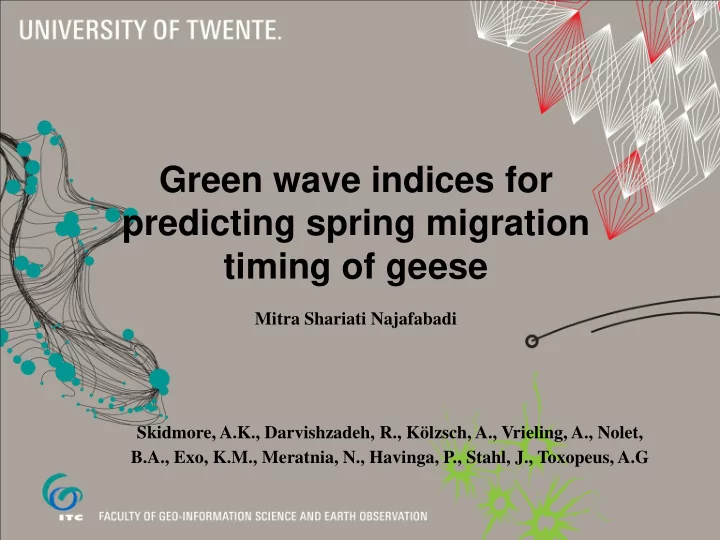

Green wave indices for predicting spring migration timing of geese Mitra Shariati Najafabadi Skidmore, A.K., Darvishzadeh, R., Kölzsch, A., Vrieling, A., Nolet, B.A., Exo, K.M., Meratnia, N., Havinga, P., Stahl, J., Toxopeus, A.G
INTRODUCTION Green wave hypothesis Fertility & Mortality Decrease Life Expectancy Increase Arctic nesting geese • Partially capital breeders • Timing of optimal breeding condition Climate change An accurate understanding of the timing of the spring migration 1
INTRODUCTION Satellite-derived NDVI time series • Near-infrared (NIR) and red reflectance • Reasonable estimates of biomass • Photosynthetically active radiation • Direct measure of plant phenology Growing degree days (GDD) • Sum of mean daily temperature • Indirect measure of plant development 2
INTRODUCTION Hypothesis: timing of geese migration, with respect to the green wave phenology, would be predicted more accurately by NDVI than GDD 3
MATERIALS AND METHODS – green wave indices Satellite-derived green wave index (GWI) • MODIS 16-day composite NDVI dataset with a 1-km spatial resolution • GWI t = (NDVI t -NDVI min )/ (NDVI max -NDVI min ) ×100 • Date of 50% GWI 4
MATERIALS AND METHODS – green wave indices The rate of change in temperature acceleration (GDDjerk) • GLDAS on a fixed grid of 0.25 ° and at a 3-hour temporal resolution GDD = (T AVG,k − T BASE ) • • GDDjerk: the third derivative of the sigmoid function through the data points that plot the day k against GDD k • Date of first peak in GDDjerk 5
MATERIALS AND METHODS – satellite tracking data 12 female barnacle geese, Branta leucopsis 30 g solar GPS/ARGOS transmitters Tracked from 2008-2011 6
MATERIALS AND METHODS – delineation of stopover, and breeding sites Stopover: birds stopped for longer than 48 hours within a radius of 30 km Breeding site: sites used for 7 to 26 days within a radius of 30 km in the second half of June/ end of June 64 stopover sites and 30 breeding sites 7
MATERIALS AND METHODS – statistical analysis Linear mixed-effect model Fertility & Mortality Decrease Life Expectancy Increase Cross-validation with the leave-one-out procedure Bland-Altman plot with the 95% limits of agreement THE WORLD % 30 25 22.0 20 15 11.0 10 5 2009 2050 8
Results – arrival date at the stopover sites Fertility & Mortality Decrease Life Expectancy Increase Model Fixed effect Parameter ±SE t-value p-value -95% CI +95% CI GWI Intercept 21±9.76 2.15 <0.05 1.49 40.52 GWI 0.83±0.06 11.99 <0.001 0.70 0.98 +95% CI Fixed effect Parameter ±SE t-value p-value -95% CI Intercept 111.94±3.67 19.07 <0.001 103.88 119.44 GDDjerk 0.21±0.02 9.46 <0.001 0.17 0.26 GDDjerk χ 2 Random effect Variance p-value THE WORLD % 30 ID 10.9 13.83 <0.01 25 22.0 20 Year 18.88 7.84 <0.001 15 11.0 10 5 2009 2050 9
Results – arrival date at the stopover sites Fertility & Mortality Decrease Life Expectancy Increase THE WORLD % 30 25 22.0 20 15 11.0 10 5 2009 2050 10
Results – arrival date at the stopover sites 11
Results – arrival date at the stopover sites • Pearson's correlation analysis between the absolute residuals values and distance to the breeding site • GWI model: Pearson correlation coefficient=-0.01, p =0.89 • GDDjerk model: Pearson correlation coefficient=0.32, p <0.01 12
Results – arrival date at the stopover sites Fertility & Mortality Decrease Life Expectancy Increase THE WORLD % 30 25 22.0 20 15 11.0 10 5 2009 2050 13
Results – arrival date at the breeding sites Model Model Fixed effect Fixed effect Parameter ±SE Parameter ±SE t-value t-value p-value p-value -95% CI -95% CI +95% CI +95% CI Intercept Intercept 74.98±11.96 74.98±11.96 6.26 6.26 <0.000 <0.000 50.36 50.36 99.90 99.90 GWI GWI 0.50±0.07 0.50±0.07 6.77 6.77 <0.000 <0.000 0.35 0.35 0.66 0.66 GWI GWI χ 2 χ 2 Random effect Random effect Variance Variance p-value p-value ID ID 4.96 4.96 5.45 5.45 <0.05 <0.05 Year Year 7.09 7.09 11.64 11.64 <0.000 <0.000 Fixed effect Fixed effect Parameter ±SE Parameter ±SE t-value t-value p-value p-value -95% CI -95% CI +95% CI +95% CI Intercept Intercept 103.35±16.37 103.35±16.37 6.31 6.31 <0.000 <0.000 70.16 70.16 137.06 137.06 GDDjerk GDDjerk 0.34±0.10 0.34±0.10 3.21 3.21 <0.01 <0.01 0.12 0.12 0.55 0.55 GDDjerk GDDjerk χ 2 χ 2 Random effect Random effect Variance Variance p-value p-value ID ID 8.88 8.88 6.35 6.35 <0.05 <0.05 Year Year 24.78 24.78 17.40 17.40 <0.000 <0.000 14
Results – arrival date at the breeding sites 15
Results – arrival date at the breeding sites 16
Discussion GWI is a more reliable index to predict barnacle goose arrival time at both stopover and breeding sites than the GDDjerk Unlike the GWI model, the GDDjerk model was sensitive to latitude Difference between the RMSD cv of the two models became smaller in breeding sites In the high Arctic environment, growing season is short and the plant growth is more rapid in relation to favorable temperatures 17
In collaboration with The Netherlands Institute of Ecology (NIOO-KNAW) Sovon Dutch Centre for Field Ornithology Institute of Avian Research, “ Vogelwarte Helgoland”
Thank you for your attention 19
Vigorous Moderate Light 20
Recommend
More recommend